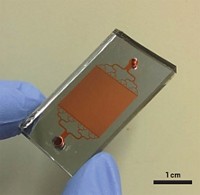Advertisement
Grab your lab coat. Let's get started
Welcome!
Welcome!
Create an account below to get 6 C&EN articles per month, receive newsletters and more - all free.
It seems this is your first time logging in online. Please enter the following information to continue.
As an ACS member you automatically get access to this site. All we need is few more details to create your reading experience.
Not you? Sign in with a different account.
Not you? Sign in with a different account.
ERROR 1
ERROR 1
ERROR 2
ERROR 2
ERROR 2
ERROR 2
ERROR 2
Password and Confirm password must match.
If you have an ACS member number, please enter it here so we can link this account to your membership. (optional)
ERROR 2
ACS values your privacy. By submitting your information, you are gaining access to C&EN and subscribing to our weekly newsletter. We use the information you provide to make your reading experience better, and we will never sell your data to third party members.
Materials
Sorting Cells In Dishes
Cell Chromatography: Patterned culture dishes can separate cells based on movement
by Sarah Webb
November 20, 2012

Flow cytometry offers a powerful way to sort mixtures of cells, but it uses expensive equipment and separates cells based on their size or surface molecules. Now researchers report a simple, inexpensive way to sort cells in a culture dish based on how quickly they move (Anal. Chem., DOI: 10.1021/ac302855m). They call it a cell-based analog to thin-layer chromatography (TLC).
Chia-Chi Ho of the University of Cincinnati and her colleagues demonstrated last year that they could steer the movement of cells by printing a cell-resistant polymer background that surrounded teardrop-shaped, unmodified islands on a tissue culture dish (Langmuir, DOI:10.1021/la2000206). The sticky islands, with shapes and spacing that the researchers precisely defined, act like stepping stones that direct the path of the cells. The asymmetric shape of these structures encourages forward movement instead of backtracking, Ho says.
Ho and her colleagues then wondered if they could use the same idea to separate cell mixtures. They stamped a honeycomb pattern of the teardrops onto culture dishes. Then they seeded those plates at one end with a mixture of two types of fibroblast cells, much like spotting a TLC plate. Each of the cell types had a different activated Rho GTPase, a family of enzymes that regulate cell movement.
The researchers allowed the cells to move along the patterned surfaces, and after 72 hours the two groups of cells separated on the plate. Ho and her colleagues expect to speed up the separation either by modifying the shape of the teardrop structures and their spacing or by adding chemical attractants to the culture dish.
The technology could eventually lead to diagnostic tools, since cell motility plays a role in cancer metastasis and wound healing, Ho says.





Join the conversation
Contact the reporter
Submit a Letter to the Editor for publication
Engage with us on Twitter